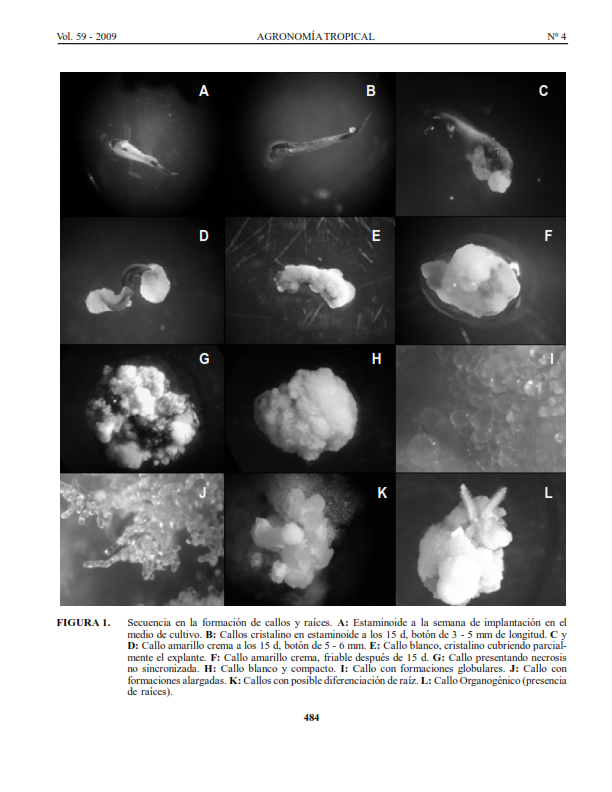Effect of the flower bud length on cocoa somatic embryogenesis
Abstract
The traditional propagation methods (sexual and asexual) in the cultivation of Cocoa, Theobroma cacao L., have not been the most convenient because plants grow up with undesirable agronomic characteristics by the producers. At present, the somatic embryogenesis seemed to be the most suitable way to produce cocoa plants of economic importance. The objective of this study was to determine the effect of the length of the flower bud (BF) has on the induction of cocoa somatic embryos (IES) from the floral structure of the genotypes Ocumare-61, Ocumare-67, Choroni-42, and Choroni-163. The callus induction (IC) was achieved by staminodes explants growing in DKW medium supplemented with TDZ, 2,4-D y 80 g l-1 of saccharose. The proembriogenic structures were transferred to DKW medium supplemented with amino acids and KNO , under conditions of darkness and 27±2 ºC to object of inducing the development of somatic embryos and to diminish the necrosis of the tissue by the effect of phenolics products. After a month of culture, a genotypic response was observed on the induction of callus, the best answer was observed in the genotype OC-61, continued by OC-67, CHO-43, and CHO-163. The last one showed the smallest percentage of the formation of callus per experimental unit. An organogenic response was observed, roots formation, in all genotypes evaluated; when these calli were cultivated in a medium for embryos development, the percentage and average number of roots for explante varied with the genotype
Downloads
References
• Alemanno L., T. Ramos Gargadenec, C. Anadry and N. Ferriére. 2003. Localization and identification of phenolic compounds in Theobroma cacao L. somatic embryogenic. Annals of Botany 92:613-623.
• Chanatásig, C. 2004. Inducción de la embriogénesis somática en clones superiores de cacao (Theobroma cacao L.), con resistencia a enfermedades fungosas. Tesis de Postgrado. Centro Agronómico Tropical de Investigación y Enseñanza (CATIE). Costa Rica. 86 p.
• Cope, F. 1976. Cacao. In: Evolution in crop plants. N.W. Simmonds Logman. London. 339 p.
• Dublín, P. 1991. Multiplicación vegetativa en Café, Hevea y Cacao. In: Cultivo de tejidos en la agricultura: Fundamentos y aplicaciones. Capítulo 26. William Roca y Luis Mroginski (Eds). Centro Inter- nacional de Agricultura Tropical (CIAT). Cali, Colombia. 970 p.
• Emons, A. 1994. Somatic embryogenesis: cell biological aspects. Acta Bot. Nerrlandica. 43(1):1-14.
• Li, Z., A. Traore, S. Maximova and M. Guiltinan. 1998. Somatic embryogenesis and plant regeneration from floral explants of cacao (Theobroma cacao L.) using Thidiazuron. In vitro Cell. Dev. Biol. Plant 34:293-299.
• López-Báez, O., L. Moreno-Martínez and S. Pacheco- Rodas. 2000. Avanzos en propagación de Cacao - Theobroma cacao – por embriogénesis somática. International Workshop on New Technologies and Cocoa Breeding. Kota Kinabalu, Sabah, Malasia. 163-177.
• Maximova, S., L. Alemanno, A. Young, N. Ferriere A. Traore and M. Guiltinan. 2002. Efficiency, genotypic variability and cellular origin of primary secondary somatic embryogenesis of Theobroma cacao L. in vitro Cell. Dev. Biol. Plant 38:252-259.
• Motamaor, J., A. Risterucci, P. López, C. Ortiz, A. Moreno and C. Lanaud. 2002. Cacao domestication I: the origin of the cacao cultivated by the Mayas. Heredity 89:380-386.
• Santos, B., J. Gilreath, R. Arbona y A. Pimentel. 2005. La estadística no paramétrica para el análisis e interpretación de estudios de plagas: alternativas al análisis de la varianza. Manejo Integrado de Plagas y Agroecología 75:89-83.
• Tan, C. L. and D. B. Furtek. 2003. Development of an in vitro regeneration system for Theobroma cacao from mature tissues. Plant Science 164: 407-412.
• Traore, A., S. Maximova and M. Guiltinan. 2003. Micropropagation of Theobroma cacao L. using somatic embryo-derived plants. In vitro Cell. Dev. Biol. Plant. 39(3):61-74.
• Velásquez, R., Y. Sandrea, C. Betancourt y J. Mata. 2006. Embriogénesis somática en cultivares de cacao venezolano. Agronomía Trop. 56(1):61-74





